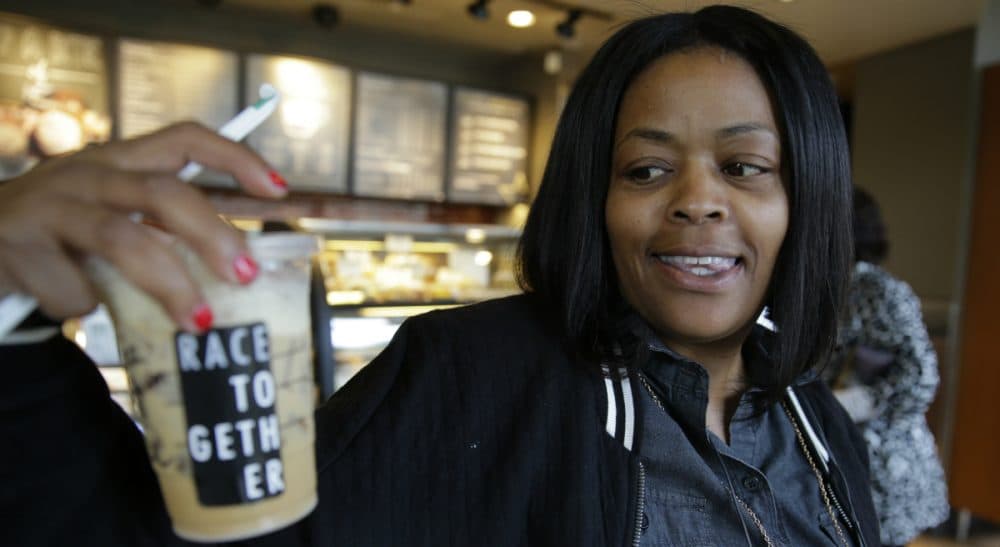Advertisement
When It Comes To Tempering Our Biases, Starbucks Has A Role — But It Has Nothing To Do With Stickers On Coffee Cups

Starbucks CEO Howard Schultz has aborted the ill-conceived and widely mocked “Race Together” initiative encouraging baristas to engage customers in conversations about race. But that doesn’t mean that Starbucks has no role to play in tempering our biases.
Important conversations often occur naturally in public spaces like Starbucks, but they are rarely about important subjects. They’re casual conversations about the weather, the Patriots or the benefits of a midday caffeine fix. They’re friendly conversations between diverse groups of people momentarily sharing a public space, looking each other in the eye, exchanging common courtesies and interacting like normal, respectful human beings. They’re everyday encounters between middle-aged regulars bantering with young baristas across racial lines about nothing in particular.
These conversations occur naturally, and in small, subtle ways they can have a greater, cumulative effect on social relations than twice as many artificial, self-consciously important discussions about race and other demographic dividers.
These conversations occur naturally, and in small, subtle ways they can have a greater, cumulative effect on social relations than twice as many artificial, self-consciously important discussions about race and other demographic dividers. Of course, they don’t inform people about institutionalized inequities. They won’t remedy racism in the criminal justice system or restore the Voting Rights Act. They can’t substitute for political action or diminish its necessity. But trivial, quotidian interactions between strangers do help ease our relations with each other.
They contribute to what Harvard professor Nancy Rosenblum has called the “democracy of everyday life,” and their value is often overlooked. These days, we’re supposed to put our faith in the diversity industry — in formal, sometimes intrusive training and consciousness raising sessions or courses in “white privilege,” which John McWhorter suggests are mere "performance art … more about feelings than action." A white privilege session is, in part, an effort to “micromanage white psychology,” he writes in a thoughtful critique, and that seems unlikely to translate into action on civil rights.
Perhaps this is a natural focus for diversity training in a therapeutic culture. It may help some white students feel better about themselves for “checking their privilege” and shouldering the guilt that accompanies their status. But guilt is an unreliable basis for political change. When it’s thrust on people, not for what they do but for who they are, guilt is more likely to spur resentment than a passion for justice, which is what motivates the white civil rights activists I’ve known.
Will diversity training or forced conversations about race help limit “micro-aggressions"? Perhaps, if people are conditioned to self-censor out of fear of being sent to the corner for committing micro-offenses. But timid self-censorship seems less likely to ease race relations than to exacerbate their tensions. Besides, micro-aggressions are probably a fact of life for all of us, regardless of our demographic status. Tribalism comes naturally to human beings. We can and should endeavor to limit its most aggressive, destructive tendencies, but we’re all going to encounter people who dislike us because of who we are or appear to be.
When it’s thrust on people, not for what they do but for who they are, guilt is more likely to spur resentment than a passion for justice, which is what motivates the white civil rights activists I’ve known.
“An anti-Semite is someone who hates Jews more than he should,” my late father in law quipped, expressing a blackly humorous view of bigotry common to his generation of Jews, born in the early 20th century. He didn’t mean that Jewish people deserve to be hated. He meant that they would always encounter some degree of irrational antipathy. We would never eliminate anti-Semitism, but we could tame it, and limit its effects.
How? Partly by co-existing, by becoming accustomed to each other. Of course co-existence is no guarantee of safety; there are never any guarantees. People living side by side sometimes turn on each other, quite murderously; such is human nature. But it must be easier to turn on people you objectify, and it’s harder to objectify people you encounter casually, routinely, everyday, and learn to feel at home with.
